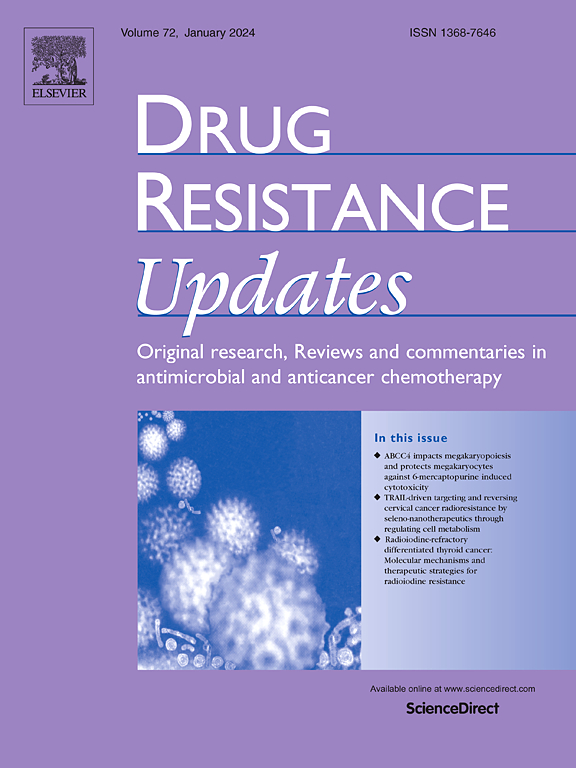Defining homologous recombination deficiency status in pancreatic ductal adenocarcinoma: Clinical implications for evaluating response to platinum chemotherapy
IF 21.7
1区 医学
Q1 PHARMACOLOGY & PHARMACY
引用次数: 0
Abstract
Aims
Pancreatic ductal adenocarcinoma (PDAC) remains a daunting malignancy with limited therapeutic options; effective biomarkers are needed to improve its treatment decision-making. The aim of this study is to evaluate the role of homologous recombination deficiency (HRD) in assessing the response to platinum chemotherapy in PDAC.
Methods
A retrospective analysis was conducted on 264 patients diagnosed with PDAC. Tumor tissue samples were subjected to next-generation sequencing (NGS) to assess DNA damage repair (DDR) gene mutation landscape and HRD score. The integrated HRD score was calculated as the unweighted sum of loss of heterozygosity (LOH), telomeric allelic imbalance (TAI), and large-scale state transition (LST) scores. The associations between HRD status and clinical outcomes in patients receiving platinum treatment were systematically analyzed.
Results
Patients with BRCA1/2 biallelic loss-of-function (BILOF) status and/or an HRD score ≥ 42 were predefined as HRD-positive. According to this HRD status definition, 4.9 % (n = 13) of the 264 patients were identified as HRD-positive, identifying a broader population than using BRCA1/2 BILOF alone (1.9 %, n = 5). Patients with BRCA1/2 mutations (BRCA1/2 m), presented a lower frequency of alteration in genes related to non-homologous end joining (NHEJ) and mismatch repair (MMR) genes than those with BRCA1/2 wild-type (BRCA1/2 wt), with mutations observed in 46.15 % (6/13) of BRCA1/2 m versus 72.91 % (183/251) of BRCA1/2 wt patients. The median HRD score (23) in patients with DNA damage repair (DDR) gene BILOF mutations was notably higher than that in those with non-BILOF mutations in DDR genes (9). HRD-positive patients demonstrated markedly longer progression-free survival (PFS) (median PFS 44.1 months) than HRD-negative patients (median PFS 12.2 months) when the patients received first-line platinum-based adjuvant treatment (P = 0.035). Specifically, patients with BRCA1/2 BILOF exhibited a substantial clinical benefit from platinum therapy, with none of these patients experiencing disease progression or death during follow-up.
Conclusions
BRCA1/2 BILOF plays a crucial role in identifying PDAC patients for first-line platinum-based adjuvant treatment, and HRD positive status, defined by BRCA1/2 BILOF and/or an HRD score ≥ 42, broadens the pool of eligible patients, and helps avoid ineffective treatment due to intrinsic drug resistance.
定义胰腺导管腺癌的同源重组缺乏状态:评价铂类化疗反应的临床意义
目的:胰腺导管腺癌(PDAC)仍然是一种令人生畏的恶性肿瘤,治疗选择有限;需要有效的生物标志物来改善其治疗决策。本研究的目的是评估同源重组缺陷(HRD)在评估铂化疗对PDAC的反应中的作用。方法对264例确诊为PDAC的患者进行回顾性分析。对肿瘤组织样本进行新一代测序(NGS)以评估DNA损伤修复(DDR)基因突变景观和HRD评分。综合HRD得分计算为杂合性损失(LOH)、端粒等位基因失衡(TAI)和大规模状态转移(LST)得分的未加权总和。系统分析接受铂治疗的患者HRD状态与临床结果之间的关系。结果BRCA1/2双等位基因功能丧失(BILOF)状态和/或HRD评分≥ 42的患者被预定义为HRD阳性。根据这一HRD状态定义,264例患者中有4.9 % (n = 13)被确定为HRD阳性,比单独使用BRCA1/2 BILOF(1.9 %,n = 5)确定了更广泛的人群。BRCA1/2突变(brca1 / m)患者与BRCA1/2野生型(brca1 / wt)患者相比,非同源末端连接(NHEJ)和错配修复(MMR)基因相关基因的变异频率较低,BRCA1/2 m患者的突变率为46.15% %(6/13),而brca1 / wt患者的突变率为72.91 %(183/251)。DNA损伤修复(DDR)基因BILOF突变患者的中位HRD评分(23)明显高于DDR基因非BILOF突变患者(9)。当患者接受一线铂类辅助治疗时,hrd阳性患者的无进展生存期(PFS中位数为44.1个月)明显长于hrd阴性患者(PFS中位数为12.2个月)(P = 0.035)。具体而言,BRCA1/2 BILOF患者从铂治疗中表现出实质性的临床获益,这些患者在随访期间没有出现疾病进展或死亡。结论BRCA1/2 BILOF在确定PDAC患者是否需要一线铂类辅助治疗方面起着至关重要的作用,以BRCA1/2 BILOF和/或HRD评分≥ 42为标准的HRD阳性状态扩大了符合条件的患者范围,并有助于避免因内在耐药而导致治疗无效。
本文章由计算机程序翻译,如有差异,请以英文原文为准。
求助全文
约1分钟内获得全文
求助全文
来源期刊

Drug Resistance Updates
医学-药学
CiteScore
26.20
自引率
11.90%
发文量
32
审稿时长
29 days
期刊介绍:
Drug Resistance Updates serves as a platform for publishing original research, commentary, and expert reviews on significant advancements in drug resistance related to infectious diseases and cancer. It encompasses diverse disciplines such as molecular biology, biochemistry, cell biology, pharmacology, microbiology, preclinical therapeutics, oncology, and clinical medicine. The journal addresses both basic research and clinical aspects of drug resistance, providing insights into novel drugs and strategies to overcome resistance. Original research articles are welcomed, and review articles are authored by leaders in the field by invitation.
Articles are written by leaders in the field, in response to an invitation from the Editors, and are peer-reviewed prior to publication. Articles are clear, readable, and up-to-date, suitable for a multidisciplinary readership and include schematic diagrams and other illustrations conveying the major points of the article. The goal is to highlight recent areas of growth and put them in perspective.
*Expert reviews in clinical and basic drug resistance research in oncology and infectious disease
*Describes emerging technologies and therapies, particularly those that overcome drug resistance
*Emphasises common themes in microbial and cancer research
 求助内容:
求助内容: 应助结果提醒方式:
应助结果提醒方式:


